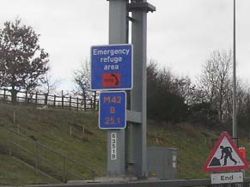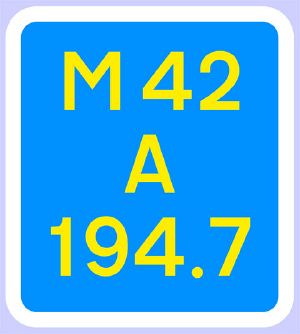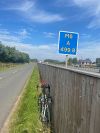Driver Location Signs
 | |
| A driver location sign on the M42 | |
| Pictures related to Driver Location Signs View gallery (20) | |
Driver Location Signs are a form of location sign that displays distance information. They are a relatively new addition to the motorway and trunk road network and for now exist only in England and in the Republic of Ireland. (In Ireland they are called Location Reference Indicators.) They are erected in addition to marker posts and are for motorists to identify the location of an emergency or defect. They were introduced in England in 2007, at the same time as the deployment of Highways Agency Traffic Officers across the trunk road network.
Historically, emergencies on motorways have been reported from fixed roadside telephones, allowing the location of the caller to be instantly identified. However, as mobile phones became increasingly popular and began, from the late 1990s onwards, to be much used much more frequently in the reporting of incidents, the need for a more precise indication of location that mobile callers to emergency services could use became evident.
Legend on Driver Location Signs
The legend on Driver Location Signs is displayed in Transport Medium, i.e. with light letters on a dark background.
Line 1 – Route number
The route number is shown on the top line.
Line 2 – Carriageway identifier
The carriageway identifier is shown on line two. The main carriageway is identified as "A" in one direction (either clockwise or in the direction proceding from the zero or datum point of the motorway) and "B" in the opposite direction (i.e. anti-clockwise or in the direction heading towards the datum point).
The datum point of a motorway may be London (for motorways, such as the M1, M2, M4, M11, etc., that radiate out from London; although oddly also the M6 and even the A74(M) as far north as J16), but it may instead be the major city that lies at one end (e.g. the M62's datum point is in central Liverpool; the M56's is in central Manchester), or it may simply be one more or less arbitrarily chosen end of the motorway (e.g. the northern end of the M66 and the western end of the M65), although in this case it usually coincides with the lowest numbered junction. The A1(M) appears to have different datum points depending on which section is being travelled, with the imperial chainage being used in the section from Scotch Corner northwards.
Any parallel adjacent carriageways (the secondary carriageway, collector or distributor roads) are identified as "C" (adjacent to the "A" carriageway) or "D" (adjacent to the "B" carriageway). Such identification occurs where there is a physical separation between the main and any secondary carriageway.
Slip roads, link roads and emergency access connections are identified as follows:
- J - Exit slip road from the A carriageway
- K – Entry slip road to the A carriageway
- L – Exit slip road from the B carriageway
- M – Entry slip road to the B carriageway
Occasionally, other letters are used at complex junctions: for instance, the part of the M3 from the inside carriageway to the A33 at junction 14 is referred to as the 'S' carriageway.
Line 3 – Chainage
Line 3 shows the distance in kilometres from a known point, e,g. the start of the route (datum point). This distance is frequently referred to – from the days when distances were measured in miles and chains – as the "chainage".
Most motorways do not actually start at 0.0, because an arbitrary figure is often added just in case the road is ever extended. Many motorways share a datum point, for instance the M6 uses the M1's datum point in central London. On the M25, the datum point is a point 5.7 km north of Junction 1 and the chainage figure increases from that point clockwise.
The chainage is expressed in kilometres to one decimal place (eg. 245.9). The distance on the driver location signs is the same as the distance shown on the smaller marker posts. One kilometre is approximately 0.621 miles.
Each sign should in principle be unique, in order to minimize confusion when an incident or defect is reported to the Police or Highways Agency.
Size, spacing and location of Driver Location Signs
Driver location signs are installed in one of two sizes, based upon the number of lanes. An x-height of 115 mm is used on carriageways with three or fewer running lanes, and 140 mm on carriageways with four or more running lanes (equivalent to 4.5 and 5.5 inches respectively). This makes the signs 975 or 1190 mm tall (38 or 47 inches respectively), with the width dependent on the legend on the sign, with an option to use a 100 mm x-height where space is limited (in tunnels or next to other structures) making the minimum height of the sign 850 mm.
Signs are located at a maximum separation of 500 m (547 yards), but this can be reduced to 400 or even 300 m to avoid slip roads and structures that would otherwise prevent the sign either from being placed at all or being visible to motorists. The first sign is positioned 100 or 200 m upstream of the first junction. On slip roads, driver location signs are placed at least 100 m upstream or downstream of the "back of nose" which is the start/end of the physical separation between the main carriageway and slip road. All signs are placed with a tolerance of plus or minus 20 m.
Driver location signs are never placed in the central reservation or on the off-side of a slip road. The signs are placed with the bottom edge 1300 mm above the carriageway and generally with a clearance of 450 mm (18 inches) from the edge of carriageway. The mounting height is increased to 2100–2300 mm where pedestrians are likely to be expected (e.g. near emergency telephones).
The 2100 and 2300 mm mounting-heights are modern metric interpretations of the older standard of 7 feet, with the taller mounting-height used in areas where signs are likely to be subject to theft or other vandalism. An even higher 2350 mm may be used where the road is likely to be used by cyclists, but such an elevation begins to limit the reflective performance of the sign face. Other standard heights of 900 and 1500 mm are referred to in the design manuals, roughly translating to 3 and 5 feet; however, the use of signs at this height (especially 900 mm) is becoming increasingly uncommon owing to vandalism, theft, and the increased maintenance burden they impose in respect of cleaning.
Materials and colours
The sign face is retroreflective Class Reference 2 to EN 12899-1:2007. Microprismatic material is not permitted, owing to the high level of reflection it produces. Regardless of the sign's being on a motorway or all-purpose road, the background colour is blue, with a yellow legend and a white border.
Marker posts
Though driver location signs are a fairly recent invention, motorways have always been equipped with marker posts which show some of the same information, but in a very much smaller typeface which it is hard to read from a moving vehicle.
Until the 1970s marker posts were spaced at intervals of 110 yards and were numbered in miles and sixteenths of a mile. Since the 1970s they have been placed at 100 m intervals and numbered in kilometres and tenths. Since 110 yards is equal to 100.584 m, the spacing is almost the same as before.
Republic of Ireland
As mentioned above, similar signs, referred to as Location Reference Indicators (LRIs), have been introduced in the Republic of Ireland. They are situated along the National (including motorway) dual-carriageway road network, and are very similar in design to England's Driver Location Signs.
The first line of text displayed on such signs indicates the road being travelled on, e.g. the N1 or M50. The second row indicates the compass direction in which the driver is travelling, which can only be N(orth), S(outh), E(ast), or W(est). The third row indicates the number of kilometres from the beginning of the road. These signs are typically placed on the nearside verge of the main line, at an inter-sign spacing of 500 m.
LRIs are supplemented by Location Reference Markers (LRMs). These are stencilled markings painted on, and parallel to, the hard shoulder every 100 metres. They indicate the route number (without prefix), the direction of travel, the direction in which the nearest emergency telephone is situated, and the distance in km from the start of the route.
LRIs on the M50 use the 'N' and 'S' designations, even between J2 and J3, where the road turns in on itself. Emergency telephones on this road are identified using the English system of 'A' and 'B'. The Dublin Tunnel is managed separately, and ramps don't have identifiers.
Links
- Roads.org.uk: Driver Location Signs
- Interim Advice Note 93/07 - Driver Location Signs Interim Performance Specification
- TII Republic of Ireland Location Reference Indicators/Markers
| Driver Location Signs | ||||||||||
| ||||||||||
| ||||||||||






